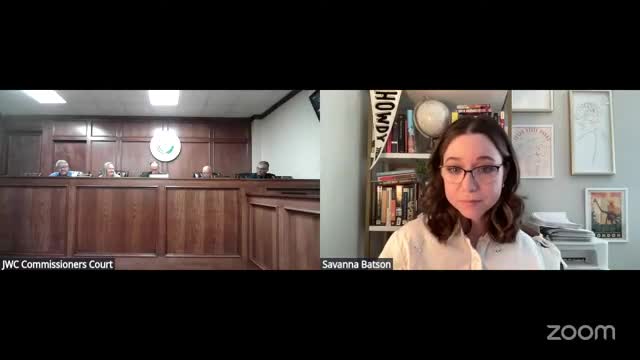Jim Wells County OKs EPA-funded Quenching Thirst project to finish Johnson Street retention pond
October 24, 2025 | Jim Wells County, Texas
This article was created by AI summarizing key points discussed. AI makes mistakes, so for full details and context, please refer to the video of the full meeting. Please report any errors so we can fix them. Report an error »

Jim Wells County Commissioners on an October meeting approved an agreement allowing the nonprofit Water Finance Exchange to administer an EPA-funded Quenching Thirst Grant, awarded to Texas A&M University–Corpus Christi, to finish improvements on a bio-retention pond on the west side of Johnson Street near the county fairgrounds.
The project, presented by Savannah Batson of Water Finance Exchange, will complete the length of pipe that had been left unfinished after construction bids rose during the COVID-19 period, install a fence around the pond and plant native species intended to improve filtration and recharge of the aquifer. Batson said, “There’s no cost to Jim Wells County for the project.”
The agreement approved by the court authorizes the county to sign a letter of engagement so Water Finance Exchange and Texas A&M–Corpus Christi can administer the grant locally, hire contractors and provide engineering oversight. The presenter said the grant is 100% funded by Texas A&M’s award and requires no county match or in-kind contribution. The presenters also described a short maintenance plan: periodic mowing and clearing of inlet pipes and installation of a small monitoring well; Texas A&M would monitor the site for about four years.
County officials asked that they be kept informed during construction so site work does not conflict with county priorities. Commissioners indicated support for the project—one commissioner said the site is in their precinct and offered assistance as needed—and the court approved the agreement with a motion and second; the clerk recorded the motion as carried.
Why it matters: the pond project targets water-quality and stormwater management improvements in an unincorporated area and was left partly unfinished after earlier bids exceeded budget; the Quenching Thirst award provides funding and an implementation partner at no county expense.
What’s next: work will proceed under the grant administration by Texas A&M–Corpus Christi and Water Finance Exchange; county staff will coordinate on site access and long-term maintenance expectations as described in the engagement letter.
The project, presented by Savannah Batson of Water Finance Exchange, will complete the length of pipe that had been left unfinished after construction bids rose during the COVID-19 period, install a fence around the pond and plant native species intended to improve filtration and recharge of the aquifer. Batson said, “There’s no cost to Jim Wells County for the project.”
The agreement approved by the court authorizes the county to sign a letter of engagement so Water Finance Exchange and Texas A&M–Corpus Christi can administer the grant locally, hire contractors and provide engineering oversight. The presenter said the grant is 100% funded by Texas A&M’s award and requires no county match or in-kind contribution. The presenters also described a short maintenance plan: periodic mowing and clearing of inlet pipes and installation of a small monitoring well; Texas A&M would monitor the site for about four years.
County officials asked that they be kept informed during construction so site work does not conflict with county priorities. Commissioners indicated support for the project—one commissioner said the site is in their precinct and offered assistance as needed—and the court approved the agreement with a motion and second; the clerk recorded the motion as carried.
Why it matters: the pond project targets water-quality and stormwater management improvements in an unincorporated area and was left partly unfinished after earlier bids exceeded budget; the Quenching Thirst award provides funding and an implementation partner at no county expense.
What’s next: work will proceed under the grant administration by Texas A&M–Corpus Christi and Water Finance Exchange; county staff will coordinate on site access and long-term maintenance expectations as described in the engagement letter.
View full meeting
This article is based on a recent meeting—watch the full video and explore the complete transcript for deeper insights into the discussion.
View full meeting
